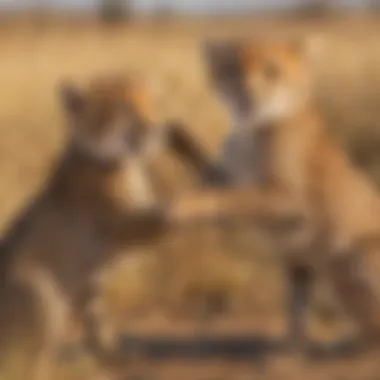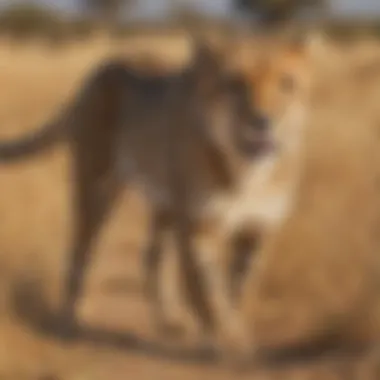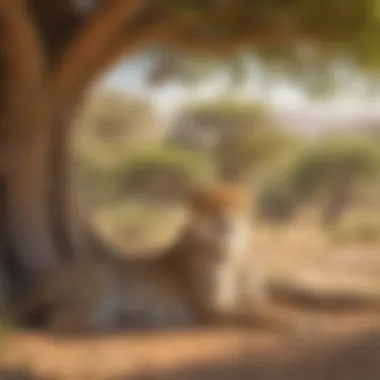Unveiling the Enigmatic Nature of Cheetahs: 5 Intriguing Insights Revealed


Fun Activities Ideas
Cheetahs are among the most fascinating creatures in the animal kingdom, known for their incredible speed and majestic appearances. Exploring five intriguing facts about cheetahs not only highlights their unique characteristics but also provides insight into their evolutionary adaptations. From their exceptional speed to intricate social dynamics, each fact unravels a new layer of these magnificent big cats that roam the African plains.
Unmatched Speed
One of the most awe-inspiring facts about cheetahs is their unmatched speed, capable of reaching up to 75 miles per hour in a matter of seconds. This incredible adaptation is essential for their hunting prowess, allowing them to chase down swift prey with unparalleled agility and precision. The cheetah's slender build, long limbs, and specialized muscles contribute to its sprinting capabilities, making it a formidable predator in the wild.
Unique Behaviors
Apart from their remarkable speed, cheetahs exhibit a range of unique behaviors that set them apart from other big cats. Unlike lions or tigers, cheetahs are solitary creatures, except during mating season or when a mother is rearing her cubs. They rely on stealth and camouflage to approach their prey unnoticed before unleashing their lightning-fast pursuit. Cheetahs also possess distinct hunting strategies, employing a combination of bursts of speed and strategic maneuvers to outwit their quarry.
Social Dynamics
While cheetahs may be solitary hunters, they have intricate social dynamics within their immediate family units. Female cheetahs are fiercely protective of their cubs, teaching them vital survival skills from a young age. Male cheetahs, on the other hand, often form coalitions with their siblings or companions to increase their chances of successfully defending their territory or securing their hunting grounds. These social structures play a crucial role in the cheetahs' ability to thrive in the competitive ecosystem of the savannah.
Evolutionary Adaptations


The evolutionary adaptations of cheetahs have fascinated scientists and researchers for generations. From their specialized binocular vision that enhances depth perception during high-speed chases to their uniquely designed claws that act as cleats for better traction, every aspect of the cheetah's anatomy is finely tuned for survival in their harsh environment. These adaptations have allowed cheetahs to evolve into one of the most efficient and successful predators in the animal kingdom, showcasing the power of natural selection at its finest.
Prolusion
Welcome to the riveting world of cheetahs, where speed, strategy, and survival intertwine to create a mesmerizing tale. In this article, we will unravel five captivating facts about these majestic big cats, shedding light on their unparalleled swiftness, hunting techniques, unique adaptations, social behaviors, and conservation status. Prepare to embark on a journey through the untamed savannahs as we explore the essence of cheetahs – nature's masterpieces sculpted by evolution's skilled hands.
At the core of our discussion lies the essence of cheetahs' existence – their remarkable speed that sets them apart as the fastest land animals. Embodying grace in motion, cheetahs' agility and acceleration will be dissected to reveal the intricacies behind their unparalleled quickness. We will delve deep into their hunting strategies, unveiling the tactics they employ to outmaneuver their prey with astonishing precision and efficiency.
Moving beyond physical prowess, we will explore the distinctive adaptations that equip cheetahs for a life of perpetual motion in the unforgiving wild. From their streamlined bodies to the pivotal role of their tail in maintaining balance during high-speed pursuits, each aspect speaks volumes of nature's intricate craftsmanship honed through millennia of evolution.
But cheetahs are not solitary spectacles; they partake in a complex tapestry of social dynamics, forming coalitions and showcasing intriguing reproductive behaviors. These communal facets of cheetah life add layers of complexity to their solitary hunting reputation, offering a glimpse into the intricate nuances of feline society.
Finally, as shadows loom over their existence, we will address the pressing issue of cheetah conservation. Their vulnerable status and the looming threats that endanger their populations serve as stark reminders of the fragile equilibrium within which these magnificent creatures strive to endure. Join us in unraveling the mysteries of cheetahs' survival and the ongoing battle to secure their future in a rapidly changing world.
Fact 1: Cheetahs' Speed
This section delves deep into the remarkable attribute of cheetahs—their unparalleled speed. Understanding the pace at which cheetahs can dart across the savannah is crucial to appreciating their hunting prowess and survival tactics. The blazing speed of cheetahs plays a pivotal role in their ability to secure prey efficiently and evade potential threats in their environment. By exploring this fact, we uncover the intricate connection between a cheetah's speed and its evolutionary success.
Cheetahs are the Fastest Land Animals


Cheetahs hold the prestigious title of being the fastest land animals globally, capable of reaching speeds up to 60-70 miles per hour in mere seconds. Their acceleration from 0 to 60 mph in just a few strides is an astounding feat of nature. This remarkable speed is not merely a physical ability but a strategic advantage honed through millennia of evolution to ensure cheetahs' survival in the competitive ecosystems they inhabit.
Fact 2: Cheetahs' Hunting Techniques
Cheetahs' approach to hunting is a marvel of precision and speed, a key feature in understanding and appreciating these magnificent creatures. In the expansive savannahs they call home, cheetahs rely on their unparalleled acceleration to close the gap between them and their prey swiftly and decisively. This fact, central to the essence of cheetah behavior, showcases their evolutionarily honed skills as expert hunters in the wild. An analysis of how cheetahs utilize their incredible speed as a crucial tool in securing their next meal unveils a world of strategy and agility unlike any other in the animal kingdom.
Cheetahs Use Acceleration to Catch Prey
Cheetahs' method of predation hinges on their exceptional acceleration capabilities, where they can reach speeds of up to 60 to 70 miles per hour in mere seconds. This burst of velocity allows cheetahs to outmatch their prey in short distances, relying on quick sprints rather than prolonged chases. By propelling themselves forward with unmatched rapidity, cheetahs can swiftly ambush their targets, utilizing an economy of motion that maximizes their hunting success. Understanding the mechanics behind how cheetahs harness acceleration as a predatory strategy sheds light on their adaptation to thrive as agile predators in their natural habitat.
Fact 3: Cheetahs' Adaptations
In this insightful article shedding light on the enigmatic aspects of cheetahs, Fact 3: Cheetahs' Adaptations take center stage, offering a profound understanding of how these magnificent creatures have evolved to thrive in their dynamic environment. Cheetahs' Adaptations serve as a critical lens through which we can appreciate the intricate mechanisms that enable cheetahs to excel in various facets of their lives. By delving deep into the specific elements of Fact 3, we unravel a tapestry of evolutionary marvels that have shaped cheetahs into the remarkable beings they are today. Exploring Fact 3 provides invaluable insights into the nuanced world of cheetahs, giving us a glimpse into the unique survival strategies and physical distinctions that set them apart from other big cats.
Cheetahs Have Unique Physical Attributes
When we contemplate the physical attributes of cheetahs, we uncover a myriad of exceptional features that contribute to their unparalleled prowess in the wild. From their slender build to their distinct black 'tear stripes' running from their eyes to their muzzle, cheetahs boast a visage that reflects both elegance and functionality. Their deep chest houses powerful lungs, facilitating rapid oxygen intake during high-speed chases, while their large nasal cavities enhance their sense of smell, aiding in locating prey across vast savannas. Additionally, cheetahs' keen eyesight, characterized by a binocular vision that optimizes depth perception, enables them to pinpoint targets with remarkable precision, ensuring successful hunts. These physical attributes collectively form the foundation of the cheetah's hunting prowess and survival in challenging ecosystems.
Cheetahs' Tail Plays a Crucial Role in Balance


A lesser-known yet vital aspect of cheetah anatomy is the pivotal role played by their tail in maintaining balance and agility during high-speed pursuits. Cheetahs' long, slender tails act as a counterbalance, allowing them to make rapid turns and sudden maneuvers without losing momentum. The tail's flexible spine grants cheetahs the agility required to navigate obstacles swiftly, showcasing their remarkable acrobatic abilities in the pursuit of prey. Through a delicate interplay of muscle control and instinct, cheetahs utilize their tails as a rudder of sorts, steering them towards successful captures while evading potential threats seamlessly. The tail's contribution to the cheetah's dynamic movements underscores the intricate adaptations honed through generations of evolution, exemplifying nature's ingenuity at its finest.
Fact 4: Cheetahs' Social Behavior
Cheetahs possess a fascinating social structure that sets them apart in the animal kingdom. Understanding the social behavior of cheetahs is crucial in unraveling the complex interactions among these graceful felines. By delving into this aspect, we gain valuable insights into how cheetahs navigate their environments and establish relationships. The ability of cheetahs to form coalitions plays a pivotal role in their survival and hunting strategies.
Cheetahs Can Form Coalitions
Coalitions among cheetahs consist of individuals usually from the same litter or siblings, working together to increase their hunting success. This cooperative behavior enhances their chances of securing prey, especially during challenging hunts. Through forming coalitions, cheetahs display a level of social intelligence that is both remarkable and essential for their sustenance.
Cheetahs Display Unique Reproductive Strategies
Cheetahs exhibit intriguing reproductive patterns, including the females' ability to reproduce with multiple males during a single mating period. This behavior, known as polyandry, ensures genetic diversity within the cheetah population. Additionally, cheetah mothers raise their cubs in isolation, minimizing the risk of cub mortality from predators or male cheetahs. These distinctive reproductive strategies contribute significantly to the survival and genetic health of cheetah populations.
Fact 5: Cheetahs' Conservation Status
The facet delving into the conservation status of cheetahs within this exhaustive article serves as a critical juncture. Understanding the conservation status of cheetahs is paramount to appreciating the precarious balance of their existence in the modern world. This section sheds light on the challenges that threaten these majestic creatures and emphasizes the urgent need for conservation efforts to ensure their survival for future generations.
Cheetahs Are Listed as Vulnerable
Diving deeper into the classification of cheetahs as 'vulnerable' unveils a concerning reality. Despite their agility and prowess, cheetahs face numerous threats that have led to their vulnerable status. Factors such as habitat loss, human-wildlife conflict, poaching, and climate change pose substantial risks to cheetah populations worldwide. By recognizing the vulnerable status of cheetahs, we come face to face with the harsh consequences of human actions on these magnificent animals.
Threats to Cheetah Populations
Exploring the threats that plague cheetah populations unveils a stark narrative. Loss of habitat due to human encroachment stands as a prominent threat to cheetahs, fragmenting their territories and limiting their ability to thrive. Moreover, poaching for the illegal wildlife trade exacerbates the decline in cheetah numbers, decimating populations for monetary gain. Climate change further compounds these challenges, altering ecosystems and diminishing suitable hunting grounds for cheetahs. Understanding these threats is crucial for devising effective conservation strategies to safeguard cheetah populations for the generations to come.



